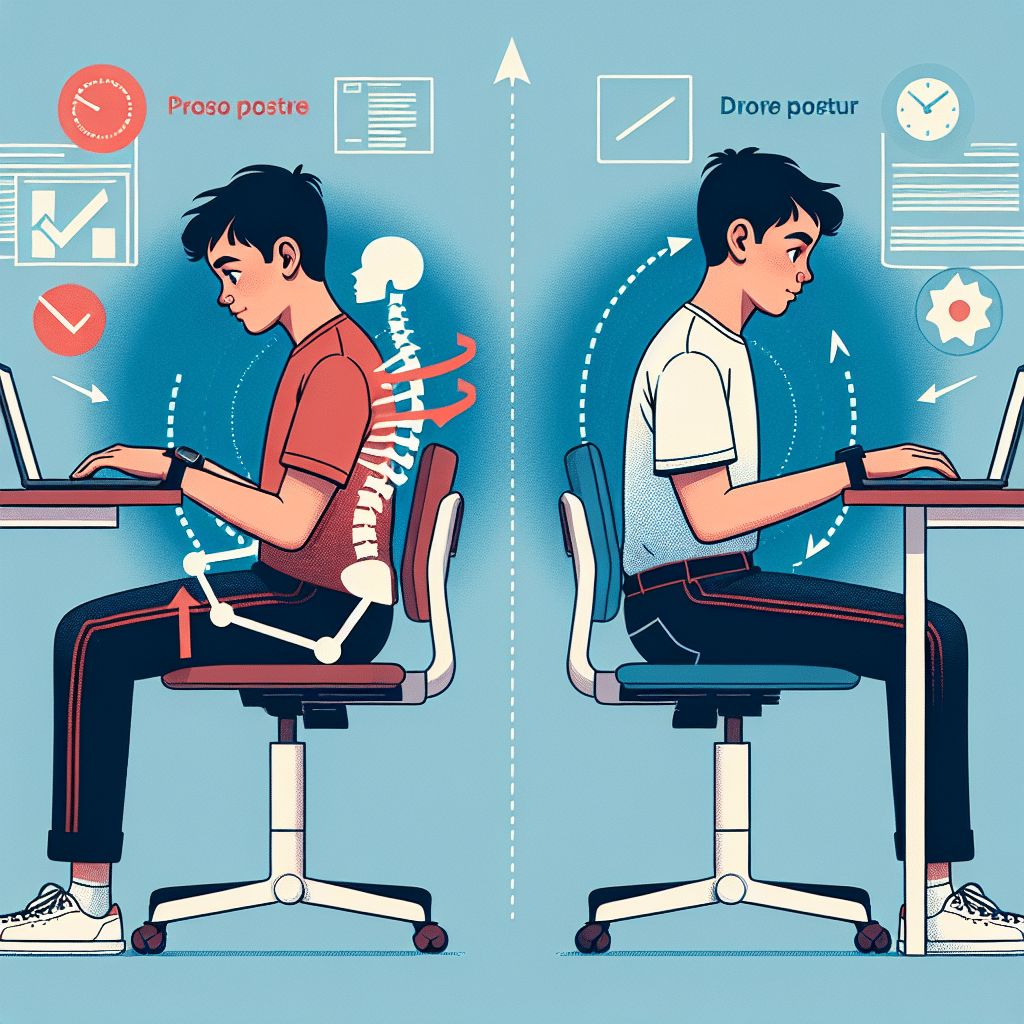Importance of Good Posture
Good posture plays a crucial role in overall health, particularly for students and remote learners who spend lengthy hours in front of screens. Maintaining proper posture helps in preventing discomfort, enhancing focus, and improving cognitive function. By being conscious of how you hold your body, you can foster an environment conducive to learning and productivity.
Understanding Posture Types
-
Neutral Spine: This is the ideal position where the spine maintains its natural curves—cervical, thoracic, and lumbar. A neutral spine minimizes stress on spinal structures and promotes proper alignment.
-
Slouched Posture: Often characterized by rounded shoulders and an exaggerated curvature of the spine. This can lead to fatigue and difficulty concentrating.
-
Crossed Legs: Sitting in a way that one leg crosses over the other can cause imbalance in the pelvis and affect circulation.
Setting Up Your Study Environment
-
Ergonomic Chair: Invest in a chair that supports the natural curve of your spine. Look for features like adjustable height, lumbar support, and armrests. An ergonomic chair promotes good posture and reduces fatigue over long study sessions.
-
Desk Height: Your desk should be at or just below elbow height when you are sitting. This helps prevent slouching and maintains a straight back.
-
Screen Positioning: Keep your computer screen at eye level, about an arm’s length away. You shouldn’t have to look up or down significantly, which can cause neck strain.
-
Keyboard and Mouse: Position your keyboard and mouse so that your wrists remain neutral and your elbows are at roughly a 90-degree angle. This minimizes wrist strain and supports a relaxed posture.
Stretching and Movement
-
Regular Breaks: Implement the 20-20-20 rule—every 20 minutes, take a 20-second break to look at something 20 feet away. This helps reduce eye strain and encourages movement.
-
Dynamic Stretching: Incorporate stretches and brief exercises every hour. Focus on neck, shoulder, and back stretches to relieve tension. Simple movements like rolling your shoulders or twisting your torso can refresh your posture.
-
Standing Desk Options: Alternating between sitting and standing can improve circulation and reduce discomfort. If possible, use a height-adjustable desk that allows you to switch positions seamlessly.
Posture Awareness Techniques
-
Mindfulness Practices: Implement mindfulness techniques to increase awareness of your body and posture. Take moments during your study sessions to assess your position and make corrections.
-
Posture Reminders: Set reminders on your phone or computer to check your posture every so often. A simple vibration or notification can prompt you to straighten your back or adjust your sitting position.
-
Body Scanning: Periodically perform a quick body scan to notice any areas of tension. Relax the muscles that are tight, and ensure your shoulders are back and relaxed.
Breathing and Its Impact on Posture
-
Diaphragmatic Breathing: Practice deep breathing from the diaphragm rather than shallow chest breathing. This helps promote relaxation and keeps your torso upright.
-
Focus on Exhalation: Concentrate on longer exhalations, which can slow your heart rate and lower stress levels, leading to a more natural sitting position.
Developing Good Sitting Habits
-
Feet Flat on the Ground: Always keep your feet flat on the ground to support your body effectively. If your feet don’t touch the floor, consider using a footrest.
-
Avoiding Slouching: Be conscious of your back. Use a chair with good lumbar support to help maintain the natural curve of your spine.
-
Take Advantage of Supportive Cushions: A small pillow or lumbar roll can provide additional support, promoting better posture.
Importance of Nutrition and Hydration
-
Hydration: Staying hydrated is vital for maintaining focus. Dehydration can lead to fatigue and improper posture due to lethargy. Keep a water bottle nearby to ensure you consume adequate fluids throughout the day.
-
Balanced Diet: Foods high in Omega-3 fatty acids like fish and walnuts can help reduce inflammation and muscle tension, contributing to better overall posture.
Benefits of Exercise
-
Strengthening Core Muscles: Engage in exercises that strengthen your core muscles, such as planks or bridges. A strong core is essential for maintaining good posture, especially during long periods of sitting.
-
Posture-specific Workouts: Incorporate yoga or Pilates into your routine. These practices are focused on body alignment and flexibility, enhancing your ability to maintain good posture throughout the day.
Utilizing Technology
-
Posture-Tracking Devices: Consider using wearable technology or apps that monitor your posture. They can send alerts when you slouch or when it’s time to take breaks.
-
Educational Resources: Use online platforms to find tutorials or seminars focused on ergonomics and posture. This knowledge can empower you to make better choices regarding your sitting habits.
Conclusion on Fostering Good Posture
By incorporating these posture tips and combining them with regular movement, stretching, and a focus on your study environment, you can create a balanced approach that enhances your focus. Regular attention to posture leads to improved concentration, a decrease in discomfort, and an overall better learning experience. Remember, good posture not only improves your physical health but also sets the stage for cognitive clarity and productivity.
